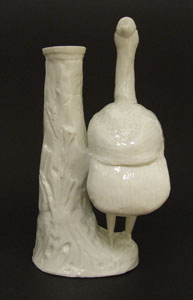
KANGXI 1662 – 1722 Blanc de Chine Porcelain
A Rare Pair of Large Kangxi Blanc de Chine Porcelain Models of Cranes with Spill Holders in the Form of Old Trees. Kangxi c.1680 – 1720.
SOLD
- Condition
- One bird in perfect condition, the other bird has been broken off its base just above it's feet and also broken away from the 'tree' behind, the beak and the tuft of feathers on it's head have been restored (probably made up).
- Size
- Height : 11 inches (28 cm)
- Provenance
- Probably see S. Marchant & Son: Blanc de Chine (Introduction by John Ayers, S.Marchant & Son, 2006. ISBN 0-9554009-0-2) page 94, plate 62.
- Stock number
- 22950
- References
- A related Blanc de Chine model of a bird is illustrated in see : Blanc de Chine (P.J. Donnelly, Faber and Faber, 1969. ISBN 571-08078-2) plate 112 B. An interesting English salt-glazed stoneware copy of this model described as a "Wading Bird" and dated to c.1750-1760, is on view at the Fitzwilliam Museum, Cambridge. Dr J. W. L. Glaisher Bequest C812-1928. For a English salt-glazed stoneware model copying the original Kangxi blanc de Chine porcelain version with decoration that is related to the Limehouse group but attributed to William Duesbury see : Transactions, Volume 19, Part 1 of the English Ceramic Circle (2005). This rare English enamelled example now the Colonial Williamsburg Collection has been attributed to Duesbury on because of descriptions in his London account book of 1751-1753.
Information
Blanc de Chine Porcelain :
The porcelain known in the West as Blanc de Chine was produced 300 miles south of the main Chinese kiln complex of Jingdezhen. The term refers to the fine grain white porcelain made at the kilns situated near Dehua in the coastal province of Fujian, these kilns also produced other types of porcelain. A rather freely painted blue and white ware, porcelain with brightly coloured `Swatow` type enamels as well as pieces with a brown iron-rich glaze. However, it is the white Blanc de Chine wares that have made these kilns famous. The quality and colour achieved by the Dehua potters was partly due to the local porcelain-stone, it was unusually pure and was used without kaolin being added. This, combined with a low iron content and other chemical factors within the body, as well as the glaze, enabled the potters to produce superb ivory-white porcelain. White porcelain was made at the Dehua kilns from early times, some books refer to the white porcelain produced during the Yuan period as being Blanc de Chine, but I think it is not really until the latter stages of the Ming dynasty, during the late 16th century, that a porcelain with clearly recognisable Blanc de Chine characteristics was produced. There is a theory that there was a brake in production during a large part of the 18th century. I am highly sceptical of this, it seams likely that Blanc de Chine porcelain was made all the way through, uninterrupted from the Ming dynasty to the present day.
Cranes / He :
One of the most important birds represented in Chinese art is the crane, He. It is a very popular motif representing longevity, it often combined with other longevity symbols such as the pine or shoulou. It`s white feathers further emphasis the connection with long life. Folklore says the crane can live more than six hundred years and has the ability to carry the souls of the dead to the Western Paradise. A pair of cranes represents a wish for a long marriage, a crane can be used in a pun for `together`. A crane flying is symbolic of a wish for a rise in status, among the nine ranks for civil officials the crane represents the first rank.